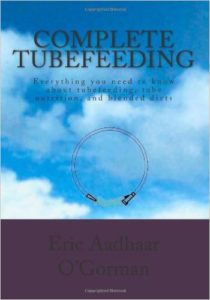The Facts About “Nutritionally Complete”

The Facts About “Nutritionally Complete”
This is a special guest blog post by Alissa Rumsey MS, RD, CDN, CSCS
As a clinical dietitian at one of New York’s largest hospitals I worked with thousands of patients with a feeding tube. In the hospital, my go-to tube feed source was a typical commercial enteral formula. I was taught that these formulas were “nutritionally complete” and often shared this with my patients and families when I taught them about tube feeding.
Most dietitians and healthcare professionals in the tube feeding world use the term nutritionally complete just as I did, without a second thought. But once I began working with people who use real food in their tube, I realized that most people don’t fully understand this idea of nutritionally complete and believe it to be more important than it is. Here’s why I don’t prescribe to the concept of a “nutritionally complete” formula anymore.
What does nutritionally complete actually mean?
A tube feeding formula is considered nutritionally complete if: it provides 100 percent of the recommend values of carbohydrates, protein, fat, vitamins, and minerals and can be used on its own as a sole source of nutrition. While it may be easy to have an all-in-one formula that you can just open and pour, and that we as medical professionals can recommend knowing the patient is receiving everything he or she technically requires to live, this doesn’t necessarily mean these formulas are best, especially for long-term use.
Most people placed onto feeding tubes are trying to gain weight, meaning they need more calories from proteins, fats, and carbohydrates than someone of a similar age. The RDIs were created for healthy people and the population as a whole, which is generally not underweight. If a child is put onto a 1500 daily calorie plan of a typical pediatric enteral formula, they will be getting up to 150% of certain vitamins and minerals, which may be too much for many children. This is the biggest issue with “nutritionally complete”: Once the vitamins and minerals are in a formula, there is no way to take them out.
Aside from unintentionally prescribing higher-than-recommended levels of RDIs, what if the patient is on a medication that interacts with certain vitamins and minerals? What if your blood level of a certain mineral is too high? There’s no way to adjust the nutrients in the pre-made “nutritionally complete” formulas. Compare this to using a product like Real Food Blends that doesn’t contain any added vitamins and minerals. You can easily add the desired amount of vitamins and minerals to your blended meal, providing more or less of different nutrients based on your individual needs.
Another important point to think about is synthetic versus food-derived vitamins and minerals. Fruits, vegetables, and whole grains are full of nutrients and phytochemicals that can improve vitamin and mineral bioavailability and absorption. While the vitamins may be chemically identical, there is some research to support that the synthetic forms, like those found in commercial formulas, are not as well absorbed and utilized as the form found in whole foods.

Nutritionally Complete vs. Nutritional Variety
Nutrition is a complicated science. We have only scratched the surface of understanding how our bodies use nutrients and which of those are essential. The nutritionally complete formulas assume that we know all there is to know about what makes something nutritionally complete, when in reality we don’t. Just because something is thought of as nutritionally complete does not mean it is the perfect food. As Eric Aadhaar O’Gorman said in the book Complete Tubefeeding, “Commercial formula companies do a good job of trying, but can never replicate the sort of spread of nutrients that a varied diet gives us.”
Think about people who eat by mouth. No one eats the same meal and ingredients over and over again, every single meal, every single day. As a dietitian, I would never recommend that, even if the patient was taking a multi-vitamin everyday. So why are we recommending it to people on tube feeds? Nutritional variety is just as important –if not moreso- as nutritionally complete.
With my clients who eat by mouth, I talk non-stop about the importance of a varied diet. The larger the variety of foods consumed, the more variety of vitamins, minerals, antioxidants, and phytochemicals you get. Think about the wide variety of food that people eat from day to day. Now, imagine “eating” these same foods via a feeding tube. From a quality of life perspective, there is no beating real food. While someone fed through a tube can’t necessarily taste all the food, they can still smell it, burp, and get a sense of the flavors. I have one patient who desperately missed his morning cup of coffee. After getting the ok from his doctor, we started giving him some coffee through his PEG. As his wife was preparing his breakfast blend, he would sit holding the cup of coffee and enjoy the scent and smells. Once he got his breakfast, the coffee would be cooled enough, and he would give it through his PEG. The feeding experience becomes more normal when you incorporate real foods.
There are other benefits to real food. Many people have trouble tolerating commercial formulas and have GI issues like nausea, bloating, vomiting, and diarrhea. As Julie Bombacino, co-founder and CEO of Real Food Blends (and the mom of a tubie), said to me once, “If they’re pooping or puking or refusing feeds, they’re not getting ‘complete nutrition’!”
All of my patients have an improvement in gastrointestinal function when they start using real foods. Their volume tolerance improves too, and they often have no trouble taking in larger quantities of food, despite having issues with similar amounts of formula. One patient of mine was getting in less than half the calories he needed because every time he gave himself a commercial formula, he had severe nausea and reflux. Once we transitioned him to blended tube feeds using real food, his symptoms completely went away and he was able to get all the nutrients he needed.
Using Real Food Blends as your primary source of nutrition? Most people should also consider taking an age appropriate multivitamin and calcium and sodium supplements daily.
Here is the complete nutritional information for Real Food Blends meals.
Moving Beyond “Nutritionally Complete”
Some dietitians and health practitioners get caught up in the idea of developing nutritionally complete blenderized tube feeds, thinking that it is obscure and complicated. I get it; I once felt the same way. Commercial formulas seem so straightforward: calculate a total volume of formula and you know exactly how many calories, macronutrients, vitamins, and minerals that person is getting. But in reality, it’s not much more complicated with real food. Think about how you construct meals for individuals who are eating by mouth. Do you worry that they aren’t going to get all the vitamins and minerals they need? No, because you recommend a varied diet with a variety of foods from different food groups and probably a good quality, age-appropriate multivitamin for some people. The same goes for tube-fed individuals. You can plan balanced, blended tube feeds for those that want to make homemade blends, and Real Food Blends can offer easy access to whole foods as well.
It’s time to think beyond nutritionally complete and stop using commercial formulas just because it’s what we’ve always done and it checks all the boxes for complete nutrition on a piece of paper. I challenge you to think about feeding people with feeding tubes similarly to those who eat by mouth. We need to balance how easy it is to prescribe commercial formulas with remembering how people actually eat and SHOULD eat (hint: not the same thing for every meal every day, but a wide variety of vegetables, fruits, whole grains, seafood, meats, and more). People with feeding tubes experience many of the same feelings we as oral eaters do – the smell of food, the taste of food, feeling of being full or bloated after a big meal – and their bodies deserve to reap the benefits a wide variety of whole foods can offer.

Alissa Rumsey MS, RD, CDN, CSCS is a nationally recognized Registered Dietitian based in New York City. While working in the intensive care unit at New York-Presbyterian Hospital, Alissa quickly saw the long-term effects that poor nutrition and physical inactivity could have on the body. After working for six years with critically ill adults, she developed Alissa Rumsey Nutrition & Wellness Consulting to help others improve their health and wellbeing. She consults with a variety of home tube feeders to help optimize their tube feed diet with whole, real foods. For more information about Alissa, visit blenderizeddietrd.com and alissarumsey.com.






